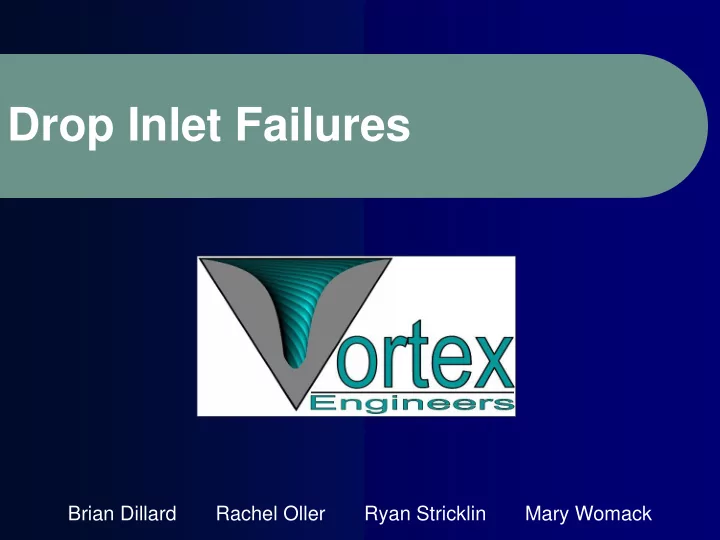

Drop Inlet Failures Brian Dillard Rachel Oller Ryan Stricklin Mary Womack
Client Natural Resources Conservation Service Federal agency that provides assistance to private landowners. Helps improve and protect the soil, water, and natural resources of the land.
Introduction During a storm event, runoff volumes are high over agricultural land. This results in an increase of: Surface runoff Rill and gully erosion Peak discharge rate http://www.soils.agri.umn.edu/academics/classes/soil2125/img/10riller.jpg
Grade Stabilization Structures GSSs stabilize grades by moving runoff through artificial or natural channels. GSSs are effective in: Controlling runoff volumes Preventing advancement of gullies Stabilizing land forms
Grade Stabilization Structures
Profiles of Inlet Structures ● Canopy provided Initial design in 1950s Requires high heads more strength Low heads produce for full pipe flow full pipe flow ● Even less vortex Ineffective for GSSs Less vortex formation formation than sliced than blunt
Current Design Specifications NRCS spec. for canopy inlet dimensions. slope greater than 15%: slope less than 15%: W=0.3D; L=1.25D W=0.2D; L=0.75D
Canopy and Sliced Inlets Effective in moving large volumes of water at low heads Widely used in Oklahoma for GSSs As sizes increased, failures began occurring
Failure Definition Inlet folds inward, creating a blockage of flow. Always occurring on the left side Typically 48” diameter or greater; 16 gauge thickness.
Current Repair Options Methods currently in use: Angle-iron on rim Angle-iron top of inlet Anti-vortex baffles Convert sliced inlets to canopy inlets
NRCS Desired Results Identify causes of inlet failures Determine pipe sizes, corrugations, and gauges that need increased strength Develop new design standards
NRCS Desired Results The NRCS also requests: alternative methods for strengthening cost comparison of retrofit options
Why Corrugated Metal Pipe? Corrugation increases the stiffness of steel plates and improves strength. Lightweight and durable. The application determines corrugation size and type.
Structural Analysis of CMP The ability of CMP to support a load is derived from: Dead Loads- embankment or trench backfill, stationary superimposed surface loads, uniform or concentrated. Live Loads- Moving loads, including impacts (AISI, 1994).
Load Distributions Loads are distributed uniformly over top and bottom of pipe. Loads caused by passive pressures of the earth are said to be greater toward the center of the pipe.
Preliminary Calculations 20 Calculated hydraulic ( HGL ) and energy grade line ( EGL ). HGL h z CLP 15 l HGL,EGL(ft) Inlet 10 2 V EGL HGL 2 g Pipe Boundary 5 EGL HGL 0 -120 -90 -60 -30 0 Pipe Length(ft)
Initial Investigation Field Tour of Installation Sites Toured several installation sites in western Oklahoma Viewed failed and reinforced inlet structures
Initial Investigation Demonstration Flume Located at the USDA ARS Hydraulics Lab in Stillwater, Ok. Made observations of pipe flow characteristics through pipe inlets.
Demonstration Models Plexiglas inlet models include: Blunt Sliced Canopy Red film
Red Film Observation Modeled same failures as seen in the field Exhibited similar characteristics
Manometer Test Manometer constructed of flexible clear plastic tubing and an air pump needle. Pressure measurements taken at increments around circumference. Pressure measured by changes in water level.
Manometer Test Results Canopy Inlet Model Blunt Inlet Model Pressure Distribution Pressure Distribution 0 0 -1.0 -0.5 0.0 0.5 1.0 -1.0 -0.5 0.0 0.5 1.0 -5 -5 Pressure (cm water) Pressure (cm water) -10 -10 -15 -15 -20 -20 -25 -25 Distance from vertical centerline (in) Distance from vertical centerline (in)
Future Investigation Physical modeling Redesign flume Plastic corrugated tubing 3” – 6” diameters Numerical modeling
Conclusion Investigation is ongoing into the forces that the pipe is experiencing Further testing of inlet structures with physical models Determine reinforcement methods that need to be implemented
Acknowledgments Vortex Engineers would like to thank the following for their help: Chris Stoner, NRCS Baker Eeds, NRCS Sherry Hunt, ARS Kem Kadavy, ARS Dr. Glenn Brown, OSU Dr. Paul Weckler, OSU
Recommend
More recommend